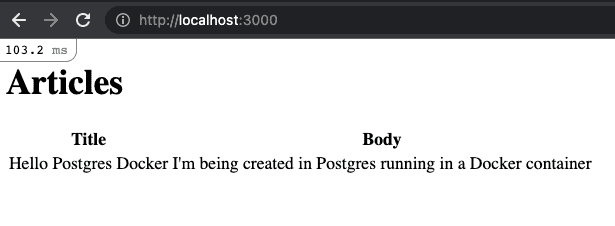Setup a Rails Project with Postgres and Docker

Update (May 2025): Added instructions for customizing the PostgreSQL configuration file postgresql.conf used by the Docker container. See modify config file section for more details.
Update (September 2023): Rails projects using fixtures will need one additional permission for the Postgres role. See initialization section for more details.
When scaffolding a new Rails project, the database flag can be used to specify a database other than the default SQLite, such as Postgres. However, the generated configuration will assume that the database is running on localhost, i.e. installed directly on your laptop or development machine. If instead you'd like the database running in a Docker container, a few more steps are necessary. This post will walk you through how to setup a new Rails project with a Postgres database running in a Docker container rather than the default SQLite running on localhost. It will be demonstrated using the Rails Getting Started Guide which builds an example blog application. All the code explained in this post can be found in this blogpg project on Github.
Why?
But first, why would you want to use Docker to run your development database rather than simply installing it on your machine? There are a few benefits including:
Version consistency: Ideally, everyone on the team is running the same version locally as what's used in production. Suppose the production version gets upgraded, then every developer needs to remember to also upgrade their local installation. When the service is dockerized and run with Docker Compose, an upgrade just involves updating the image tag in the docker-compose.yml file and pushing to version control. Next time everyone pulls that change and runs docker-compose up, they'll automatically get the upgraded version. Version consistency also eliminates a source of works on my machine problems.
Configuration consistency: If your project requires some custom database configuration, it can be committed into the project and set in the container with a host mount. This leads to faster local setup as compared to adding an instruction in the README.md telling each developer to configure their database manually.
Multiple versions and services:: For a developer that works on multiple projects, they could be using different database versions and it would be tedious to have to constantly uninstall/re-install versions every time you switch projects. Also as you work on multiple projects, each may have different service requirements such as Postgres, MySQL, Elasticsearch, Redis, etc. I'd rather not have all of those always running on my laptop when not needed, or have to remember to start/stop them for each project. Using Docker, with Docker Compose simplifies this.
Now that we've covered some benefits of using Docker locally for services, let's see how to setup Postgres in a container for a new Rails project.
Getting Started
Install Postgres locally. Even though the Postgres database server will be run inside a Docker container, we still need the client installed on our laptop to connect to it. For a Mac, the easiest way is to use Homebrew. Note that you need to select your version. It's not necessary to start the service, so ignore the instruction at the end of the installation about starting Postgres.
brew install postgresql@14Scaffold a new Rails app, but specify that you want the database to be Postgres. Otherwise, the default option will use a SQLite database:
rails new blogpg --database=postgresqlDocker Compose
We'll use Docker Compose to manage starting and stopping containers. Typically Docker Compose is used to manage multiple services, but there's still benefits to using it even if you only have one service as in this case. It's more convenient to start a container with a simple command docker-compose up than to use the equivalent docker run... because the compose file handles passing in all arguments such as volumes, port mapping and environment variables. Also as the project grows, more services such as Redis, Sidekiq, etc may be added that will each require their own container. Using Docker Compose means they can all be started with a single command.
Add the following docker-compose.yml file to the root of the project:
version: "3.8"
services:
database:
image: postgres:14
volumes:
# Named volume to persist database data outside of container.
# Format is "named_volume:path/in/container"
- db_pg_data:/var/lib/postgresql/data
# Host mount for one-time initialization.
# Format is "./path/on/host:/path/in/container"
- ./init.sql:/docker-entrypoint-initdb.d/init.sql
ports:
# Map to something other than default 5432 on host in case Postgres
# is also running natively on host.
# Format is "host:container"
- "5434:5432"
environment:
# Sets the superuser password for PostgreSQL
POSTGRES_PASSWORD: shhhhItsASecret
volumes:
db_pg_data:A few things to note here:
image: This specifies what image to use. By default, it will pull from the Docker Hub public registry. The postgres image refers to the Official Postgres Image. Notice that the version tag 14 is specified. If you don't specify a tag, latest will be pulled which may not be what you want. Optionally you can use the 14-alpine tag for a more minimal image.
ports: By default, Postgres listens on port 5432. When the database is running in a container rather than directly on the local machine, this port must be mapped to a port on the host, in order for the Rails application to be able to connect to it. Typically, you'll see the container port mapped to same port number on the host such as "5432:5432". I prefer to choose a different port to map to on the host in case anyone on the team happens to be running Postgres locally on the default port, maybe from an earlier tutorial, or even just installing the client via homebrew, they may have chosen to start the service. The idea here is to avoid a port conflict where Docker is trying to use a port that's already in use by the host. Learn more about ports.
volumes: There are two entries in the services - volumes section. The first is a named volume db_pg_data:/var/lib/postgresql/data. This maps the directory inside the container where Postgres stores all the data to a Docker volume named db_pg_data, which is defined at the end of the file in the volumes section. This will save all data outside of the container (you can list your volumes with the docker volume ls command). This means even if the container is removed, your data is still available.
The second is a host mount ./init.sql:/docker-entrypoint-initdb.d/init.sql. It maps a file ./init.sql from the project root (we'll create it in the next section) to a special directory in the container docker-entrypoint-initdb.d. This is a property of the official Postgres Docker image. Any sql files located in this directory can be used for one-time initialization. That is, when the container starts, it checks if the default postgres database already exists, if not, it runs all sql scripts found in the initdb directory. If a database does exist, then the files are ignored. Learn more about volumes.
environment: This section is used to set environment variables that will be available within the container. POSTGRES_PASSWORD sets the superuser password for the postgres user. Remember this is only a development image so this password isn't being used to protect production data. Optionally, you can set the POSTGRES_HOST_AUTH_METHOD to trust, and then the POSTGRES_PASSWORD environment variable is not required. Learn more about setting environment variables in Docker Compose.
Initialization
The docker-compose.yml file explained in the previous section specifies a host mount for init.sql. When the Postgres container is run for the first time, it will detect that there is no default postgres database created yet, when this is the case, it will run all sql scripts located in the docker-entrypoint-initdb.d directory. Otherwise, if a default database does exist, this directory is ignored. This makes it perfect for performing one-time initialization.
We'll use this feature of the Postgres image to create a role having the same name as the Rails database, in this case blogpg for our sample blog application. Create a file init.sql in the root of the Rails project with the following content:
-- Only used for development where Postgres is run in Docker
create role blogpg with CREATEDB login password 'blogpg';If your project uses fixtures for loading sample data, you may encounter the following error when running bin/rails db:seed or when running tests, both of which attempt to load the fixtures via db:fixtures:load:
WARNING: Rails was not able to disable referential integrity.
This is most likely caused due to missing permissions.
Rails needs superuser privileges to disable referential integrity.
cause: PG::InsufficientPrivilege: ERROR: permission denied: "RI_ConstraintTrigger_c_24650" is a system trigger
Tasks: TOP => db:fixtures:loadThis is because when loading fixtures, Rails first deletes all the existing data in the database, and the fastest way to do that is to first disable referential integrity (i.e. foreign keys and check constraints). However, Postgres requires that the user doing this must have a role with SUPERUSER privileges. The role created in the example above only has CREATEDB privilege which is insufficient. To resolve this, include SUPERUSER privilege when creating the role as follows:
-- Only used for development where Postgres is run in Docker
create role blogpg with CREATEDB SUPERUSER login password 'blogpg';According to the Postgres docs on creating roles:
Superuser status is dangerous and should be used only when really needed.
In this case, it is only being used for development purposes. Your production role should not have this.
Rails Database Config
The next step is to modify config/database.yml in the Rails project so that it can connect to the database running in the Docker container for development and test. It also needs the flexibility to connect to a different database for production.
Before making changes to this file, let's take a look at what gets generated from running the rails new blogpg --database=postgresql command:
# config/database.yml
default: &default
adapter: postgresql
encoding: unicode
pool: <%= ENV.fetch("RAILS_MAX_THREADS") { 5 } %>
development:
<<: *default
database: blogpg_development
test:
<<: *default
database: blogpg_test
production:
<<: *default
database: blogpg_production
username: blogpg
password: <%= ENV['BLOGPG_DATABASE_PASSWORD'] %>Notice that there's no host or port specified in the default database configuration. This is because it's assumed that the database is running on localhost, i.e. the same machine as the Rails app is running on, and listening on the default Postgres port of 5432. In our case, the database is running on the same machine, but inside a Docker container therefore localhost will not resolve. Instead we'll need to specify a host of 127.0.0.1. As for the port, recall we mapped the default Postgres port of 5432 in the container to 5434 on the host so we'll also need to tell Rails about this.
We also need to make sure that different values can be specified in production. We'll make use of environment variables for this, together with the logical or operator || to use a default when the environment variable is not specified.
Here is the modified config file to support connecting to Postgres in a Docker container for development and test, and flexibility to specify a different database host, password, etc with environment variables for production:
default: &default
adapter: postgresql
encoding: unicode
pool: <%= ENV.fetch("RAILS_MAX_THREADS") { 5 } %>
database: <%= ENV['DATABASE_NAME'] || "blogpg" %>
username: <%= ENV['DATABASE_USER'] || "blogpg" %>
password: <%= ENV['DATABASE_PASSWORD'] || "blogpg" %>
port: <%= ENV['DATABASE_PORT'] || "5432" %>
host: <%= ENV['DATABASE_HOST'] || "127.0.0.1" %>
development:
<<: *default
port: 5434
test:
<<: *default
database: blogpg_test
port: 5434
production:
<<: *default
database: blogpg_production
username: blogpg
password: <%= ENV['BLOGPG_DATABASE_PASSWORD'] %>Note that there's nothing Docker-specific in the config/database.yml file. All we've done is make it more flexible than what the Rails scaffold generated so that development and test can connect to databases other than that running on localhost and the default port.
Start Container
Now it's time to try all this out and make sure everything's connected. Start the container(s) with docker compose:
docker-compose upSince this is the first time this container is running, the default postgres database doesn't yet exist, so the console output should show that the init.sql script was run to create the blogpg role:
database_1 | /usr/local/bin/docker-entrypoint.sh: running /docker-entrypoint-initdb.d/init.sql
database_1 | CREATE ROLE
...
database_1 | 2022-09-06 10:33:56.184 UTC [1] LOG: database system is ready to accept connectionsNote that you can stop the database at any time with docker-compose stop and then use the up command to restart it. The CREATE ROLE from init.sql will not run again because the default postgres database already exists. Next time you start the database, the following message will be displayed:
PostgreSQL Database directory appears to contain a database; Skipping initializationForce Init
This section is optional. If you made a typo in init.sql or for whatever reason want to force it to run again, this can be accomplished by removing the named volume that contains the Postgres data (make sure there's nothing important saved there or back it up first!). Since a container exists that is using the volume, it must be stopped and removed first, here are the steps to force init to run again:
# stop the running Postgres container
docker-compose stop
# remove the container (otherwise the volume cannot be removed)
docker-compose rm -f
# list all volumes - should see blogpg_db_pg_data in the output
docker volume ls
# remove the named volume
docker volume rm blogpg_db_pg_data
# start database container again - should show its running CREATE ROLE
docker-compose upCreate Database
Next step is to create the Rails application database. Run the usual Rails command to do so:
bin/rails db:createUse the psql command line tool (this got installed with homebrew earlier) to connect to Postgres running in the Docker container to verify the application database got created. Notice this command specifies 127.0.0.1 as the host and 5434 as the port because we need to connect to the Docker container rather than a database running directly on the laptop:
psql -h 127.0.0.1 -p 5434 -U blogpg
# enter password from init.sqlUse the \l command to list all databases - you should see blogpg and blogpg_test in the listing, which were created from running the bin/rails db:create command:
blogpg=> \l
List of databases
Name | Owner | Encoding | Collate | Ctype | Access privileges
-------------+----------+----------+------------+------------+-----------------------
blogpg | blogpg | UTF8 | en_US.utf8 | en_US.utf8 |
blogpg_test | blogpg | UTF8 | en_US.utf8 | en_US.utf8 |
postgres | postgres | UTF8 | en_US.utf8 | en_US.utf8 |
template0 | postgres | UTF8 | en_US.utf8 | en_US.utf8 | =c/postgres +
| | | | | postgres=CTc/postgres
template1 | postgres | UTF8 | en_US.utf8 | en_US.utf8 | =c/postgres +
| | | | | postgres=CTc/postgres
(5 rows)Keep this tab open, we'll come back to it to verify tables after creating and populating some models.
Create and Populate Table
Now let's follow along with the Getting Started Rails Guide so we can get to the point of creating a table and populating it. Add the following to config/routes.rb to expose a route that will list all articles in the application:
Rails.application.routes.draw do
root "articles#index"
get "/articles", to: "articles#index"
endUse the Rails generator to scaffold an Articles controller and model, then run the migration (migration file got generated by the model generator) to create the articles table in the database:
bin/rails generate controller Articles index --skip-routes
bin/rails generate model Article title:string body:text
bin/rails db:migrateGo back to the tab where psql is running and verify the articles table got created in the Postgres database running within Docker container. The \dt command lists all tables in the database you're connected to:
blogpg=> \dt
List of relations
Schema | Name | Type | Owner
--------+----------------------+-------+--------
public | ar_internal_metadata | table | blogpg
public | articles | table | blogpg
public | schema_migrations | table | blogpg
(3 rows)We can see the articles table got created as well as the schema_migrations table Rails uses to keep track of migrations.
Now launch a Rails console with bin/rails console and create a new article:
Article.create(
title: "Hello Postgres Docker",
body: "I'm being created in Postgres running in a Docker container"
)Go back to the tab where psql is running and verify the new article record has been created:
blogpg=> select * from articles;
id | title | body | created_at | updated_at
----+-----------------------+-------------------------------------------------------------+----------------------------+----------------------------
1 | Hello Postgres Docker | I'm being created in Postgres running in a Docker container | 2022-09-09 10:31:13.032458 | 2022-09-09 10:31:13.032458
(1 row)Verify Full Stack
To tie this all together, let's update the Articles controller index method and the Articles index view to display the articles so we can verify the full stack is working with the Dockerized database:
# app/controllers/articles_controller.rb
class ArticlesController < ApplicationController
def index
@articles = Article.all
end
end<!-- app/views/articles/index.html.erb -->
<h1>Articles</h1>
<table>
<tr>
<th>Title</th>
<th>Body</th>
</tr>
<% @articles.each do |article| %>
<tr>
<td><%= article.title %></td>
<td><%= article.body %></td>
</tr>
<% end %>
</table>Start the server with bin/rails s, navigate to http://localhost:3000 and you should see an unstyled HTML table listing the one article created earlier:

Congratulations! You now have a running Rails application that is using a Dockerized Postgres database.
Modify Config File
Optionally, you may want to tweak the default PostgreSQL configuration. Common reasons for doing this include:
- Enabling extensions like
pg_stat_statementsfor query performance analysis. - Adjusting logging settings for better visibility of slow queries or autovacuum operations.
- Customizing memory or connection settings to better suit your local development environment.
By default, the postgresql.conf file lives inside the Docker container as part of the official PostgreSQL image. Any changes made directly in the container will be lost if the container is removed. To make persistent changes, you need to:
- Locate and copy the config file out of the container.
- Make your desired changes locally.
- Bind mount the updated file back into the container.
Here's how to do that step by step:
Step 1: Locate and Copy Config File
Connect to your running database using a superuser account:
# If your custom role has SUPERUSER privileges:
bin/rails db
# Or using the default postgres superuser:
psql -h 127.0.0.1 -p 5434 -U postgresFrom the psql prompt, check where the config file is located:
SHOW config_file;The output should look something like this:
config_file
------------------------------------------
/var/lib/postgresql/data/postgresql.confSince the file is inside the container, extract a copy for local modification:
# Create a directory in your project root to hold PostgreSQL configuration files
mkdir postgres_conf
# Pull the sample config file from the official PostgreSQL image
docker run -i --rm postgres:16 cat /usr/share/postgresql/postgresql.conf.sample > postgres_conf/postgresql.confStep 2: Modify Config File
Now you have a local copy at postgres_conf/postgresql.conf. Open the file using your editor of choice and modify the settings as needed. For example:
# Enable pg_stat_statements for analyzing query performance
# and auto_explain for slow query logging
# https://www.postgresql.org/docs/current/auto-explain.html
shared_preload_libraries = 'pg_stat_statements,auto_explain'
# Collect query performance data
pg_stat_statements.max = 10000
pg_stat_statements.track = all
# Log queries with execution duration >= 1ms
auto_explain.log_min_duration = '1ms'
auto_explain.log_analyze = on
auto_explain.log_format = json
# General logging tweaks
log_min_duration_statement = 1 # log queries taking longer than 1ms
log_duration = on # always log duration of each completed statement
# Log all autovacuum operations
log_autovacuum_min_duration = 0
# Enable CSV logging for easier analysis
log_destination = 'stderr,csvlog'
logging_collector = onStep 3: Update docker-compose.yml to use the custom config
To ensure your container uses the modified configuration file, update your docker-compose.yml with a bind mount in the volumes section:
version: "3.8"
services:
database:
image: postgres:16
volumes:
- db_pg_data:/var/lib/postgresql/data
# === ADD THIS LINE HERE ===
- ./postgres_conf/postgresql.conf:/var/lib/postgresql/data/postgresql.conf
ports:
- "5434:5432"
environment:
POSTGRES_PASSWORD: shhhhItsASecret
volumes:
db_pg_data:Then recreate the container for changes to take effect:
docker-compose down
docker-compose upPostgreSQL running in the container will now use your customized configuration.
Conclusion
This post has walked through the steps required to setup a Rails application with a Postgres database running in a Docker container. It requires adding a docker-compose.yml file to the project. This file defines the database service including what Docker image to use, port mapping, volumes, and environment variables. Then the Rails project file config/database.yml must be modified so that the development and test databases are configured to point to the Dockerized database rather than assuming they're available on localhost. Finally the psql command line tool can be used to connect to the database in the container to verify the Rails application is populating it as expected.
References
- Example Rails Project with Postgres in Docker
- Homebrew Package Manager for Mac
- Postgresql on Homebrew - notice they're all versioned now!
- Rails Getting Started Building Blog App
- Rails Command Line Option for Database
- Postgres Official Image on Docker Hub
- Postgres Docker Image Full Readme
- Postgres user vs role



